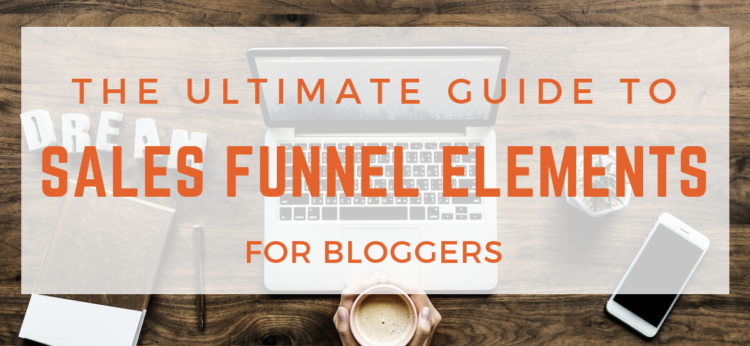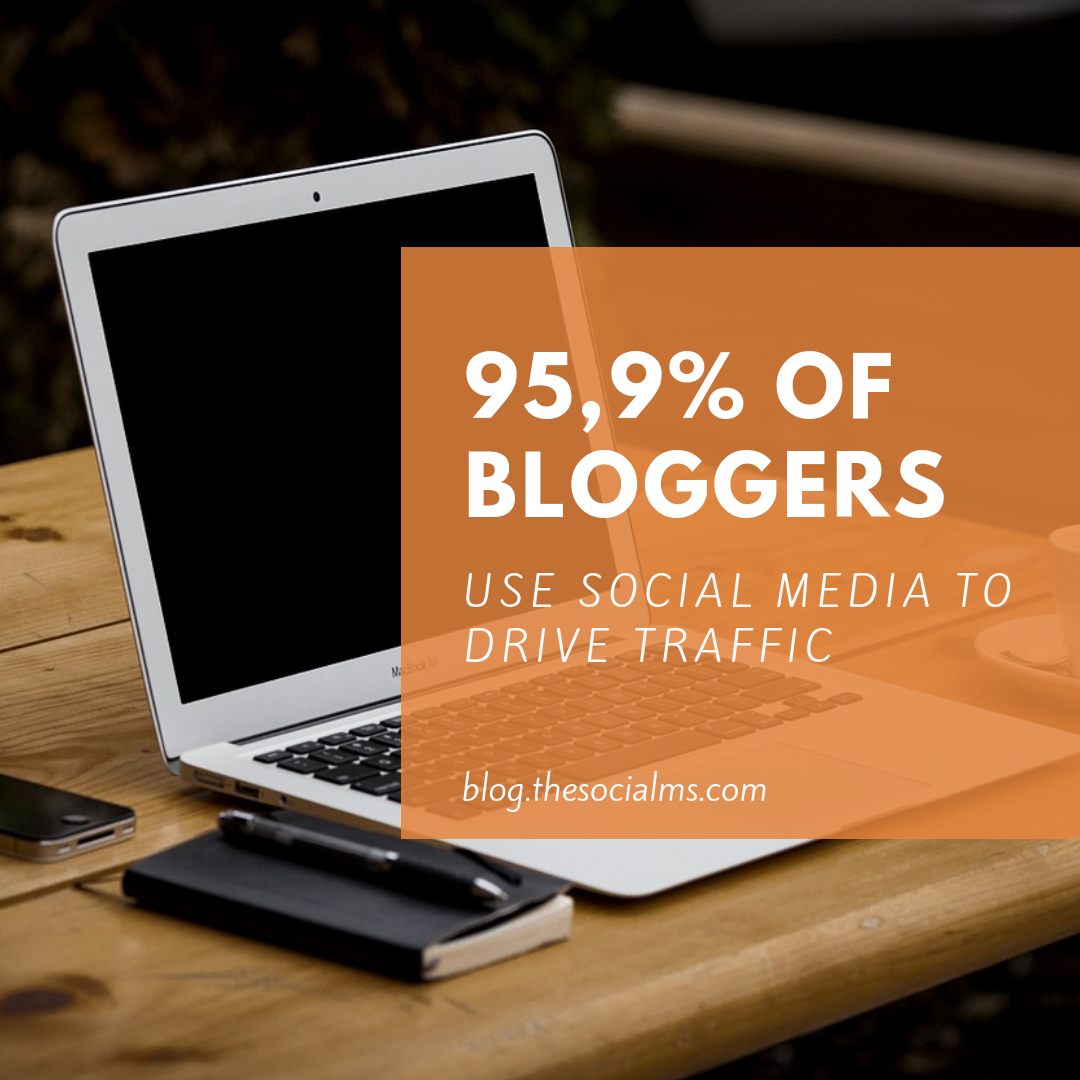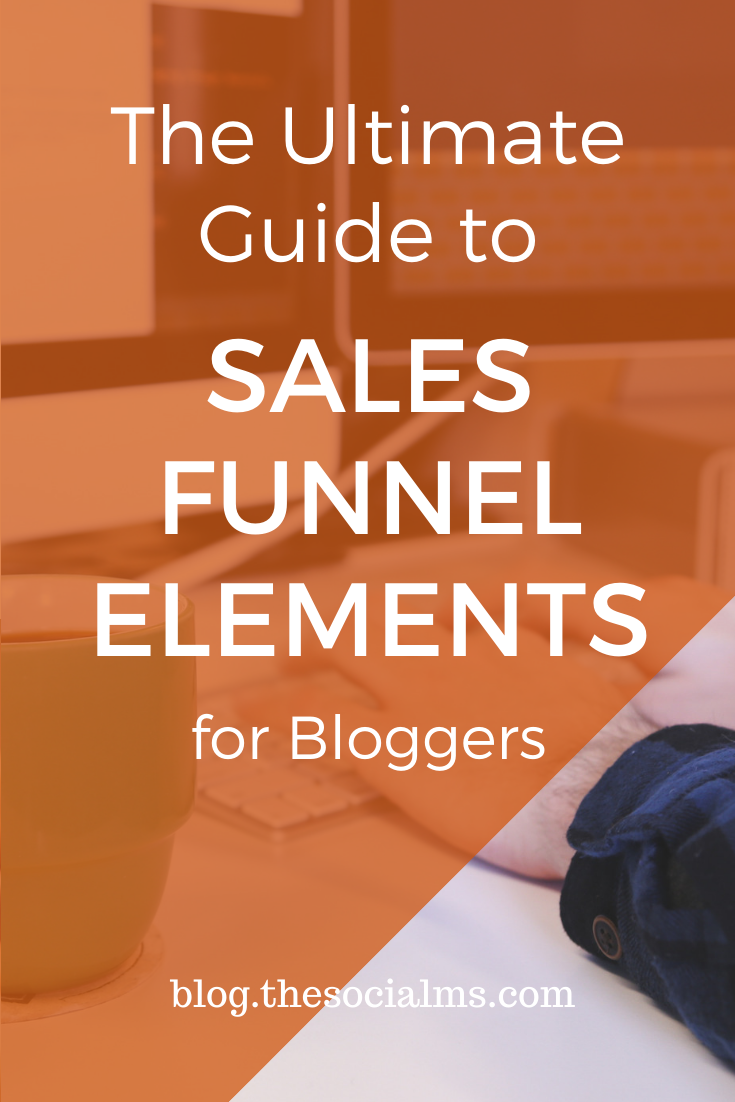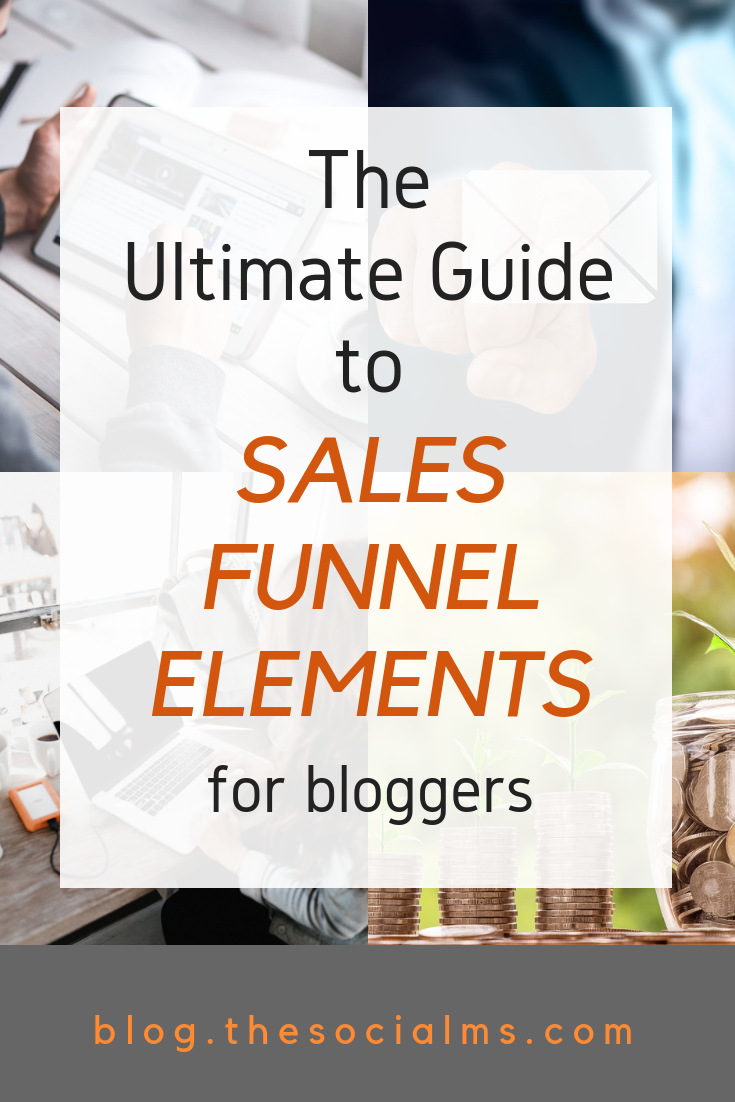You’ve heard about having sales funnel, right? You’re here because you know they are important for a blogging business – but you just can’t figure out how to create one that will turn your blogging business into a revenue machine, right?
You want to make money with your blog? You’ve got some products you want to sell, created a landing page, you have fantastic content on your blog, and maybe you even have a few sales.
But you’re not making enough sales for all of this to make sense?
Money isn’t showing up in your bank account on autopilot?
Before you read on - we have various resources that show you exactly how to use social networks to gain massive traffic and leads. For instance, check out the following:
FREE Step-by-Step Twitter Marketing GuideFREE Pinterest Marketing Ebook
Quitting your day job is far out in the future, and you’re asking yourself whether it’s time to give up?
After some googling around you find out that the solution is probably a sales funnel…
But what is a sales funnel, and what does having a sales funnel mean for bloggers?
What’s the perfect sales funnel for bloggers like you?
And most importantly: Which elements can you use to build your own sales funnel?
That’s what this post is about!
What’s a sales funnel and what are sales funnel stages?
Before we can start talking about the perfect sales funnel elements for bloggers, we first need to answer the question of what a sales funnel really is.
A sales funnel is a sequence of phases or sales funnel stages you want to lead your potential customers through, that is closely related to the typical buyer’s journey for your business.
The following sales funnel diagram shows you these four sales funnel stages, along with examples of what needs to be done in each stage.
Hey, before you read on - we have in various FREE in-depth guides on similar topics that you can download. For this post, check out:
FREE workbook: CREATE AWESOME BLOG POSTSFREE Beginner's Guide: START A BLOG
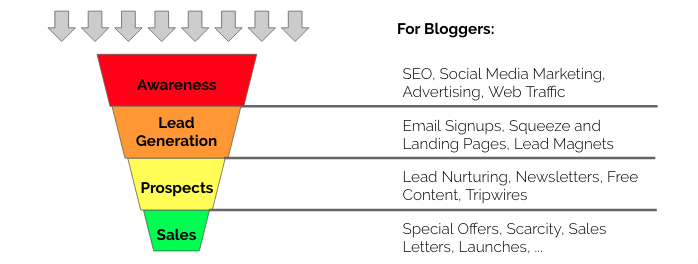
Let’s quickly cover all of these sales funnel stages before we talk about each in detail.
 It all starts with the awareness phase. This is where your future customer first becomes aware of your business.
It all starts with the awareness phase. This is where your future customer first becomes aware of your business.
Can you guess what this means for a blogging business – or any web business at all? Right, that means getting web traffic. For 99% of people in your target audience, becoming aware of your business is the same as ending up on your website – one way or another.
This is also where most bloggers already make their first mistake. Getting people to click on your website isn’t the last step in your sales funnel – it’s only the beginning.
If you only rely on making sales to people who are visiting your website, you are going to have a tough time – and make only a fraction of the amount of money you could make.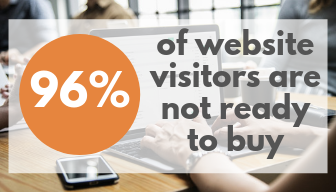
To really make your blogging business perform up to its full potential, you need to convert visitors to all 3 other sales funnel stages.
The key argument here is trust – people who hear from you the first time will not trust you enough to buy from you. And a sales funnel is there to build that trust.
The second phase of a sales funnel is the lead generation phase.
In a standard sales funnel, converting people who are aware of your business into leads means getting contact information. And for an online business that usually means building an email list.
An email list is a list of email addresses that you can contact over and over again, and to turn a web visitor into a lead, you need a sign-up form on your website.
Now that you converted your visitors into leads, it’s now time to turn them into prospects. That’s what the prospect phase is for. Or as the online
During this phase, you will send more and more information to your email list to build trust and possibly desire within the minds of your leads.
You do that by sending newsletters with helpful information to your potential customers. You may work a lot with email automation during this phase – we’ll cover this later in this post.
When a lead is finally ready to buy, this lead should enter the sales phase.
During the sales phase, you are going to use emotional triggers like scarcity (for instance through time-limited offers), desire (through bonuses) and more to convince your prospects that it is finally time to buy your offer.
Now that you have a general understanding of what a sales funnel is and what having a sales funnel means, let’s look at all the individual sales funnel stages in detail.
Sales Funnel Part 1: Awareness and Traffic
As you can see in the sales funnel diagram above, the first phase a lead must go through is the awareness phase.
Things you need for this phase:
- A blog
- Content on your blog
- Social Media Accounts
- SEO tools (Yoast, Keyword Planner, Ubersuggest…)
Making people from your target audience aware of your blog and your products is the first phase of any sales funnel.
And the key to making them aware is getting them to come to your website first. In other words, you need traffic.
But traffic itself is not enough – you always need to keep in mind, that this traffic needs to come from within your target audience. People that visit your blog need to be interested in the content on your blog and the type of products or services you want to offer.
There are three types of traffic you can get as a blogger – and if you’re starting out, only two of these are what should be recommended.
Social Media Traffic
Social media web traffic is when you manage to drive traffic to your content through websites like Twitter, Facebook, Pinterest, LinkedIn, and all the others.
The main benefit of social media traffic is that you can get almost instant results – which is why this is the first type of traffic you should start generating!
All of the leading social networks have benefits and problems, are targeted at specific people, and may or may not work for your business.
One social network that can be used almost within any niche and for any business… is Twitter. Read this to learn some ways on how to get targeted web traffic for free from Twitter:
The 3 Step Strategy To Massive Traffic From Twitter
Another social site that is highly beneficial for bloggers and often underestimated in terms of traffic power is Pinterest. Read the following post for more information on how to gain traffic with Pinterest:
How to Use Pinterest Search to Boost your Blog and Traffic
You’ll find massive amounts of information on our blog about all main social networks and how to get traffic from them – take a look around!
SEO Traffic (Search Engine Optimization)
While social media traffic is the only type of traffic you can get for free immediately, the second type of traffic you can get for free as a blogger is Search Engine traffic.
This is traffic from search engines – most importantly – Google.
Search engine traffic takes a while to generate – it can take months or even years to get massive amounts of traffic from search engines – but once you manage to get it, search engines become the traffic source that has the highest ROI for most blogging businesses.
You generate search engine traffic by optimizing your site and content for keywords around your niche and topics, by building links to your site. This way you let search engines know what your website is about (keywords) and that it is valuable (because other websites link to it).
Check out this post on how to prepare your blog for SEO: How to make Your WordPress Blog SEO Ready
Check out this post on keyword research: The Blogger’s Guide to Keyword Research
Check out this post on how to build links: 3 SEO Traffic Hacks Every Blogger Should Know: Bigger Results, Less Work
Advertising Traffic
The third type of traffic you can get with an online business is advertising traffic.
BUT: This type of traffic is not recommended when you’re starting out.
Advertising traffic is traffic that you pay for by using an advertising system like Facebook ads, Google Adwords, LinkedIn Ads, Pinterest Ads, …
The problem is that you are paying per each individual visitor – so when you go for advertising traffic you put yourself under a lot of pressure!
And when you’re not making enough revenues yet, do not have your complete sales funnel figured out, and don’t know exactly how you convert in the final phases of your sales funnel, this can get expensive fast.
You wouldn’t be the first person that would go bankrupt running Facebook Ads.
Sales Funnel Part 2: Lead Generation
Let’s move down a little in our sales funnel diagram: let’s turn traffic into leads.
What you need:
- An email marketing tool (Mailchimp, ConvertKit)
- A lead magnet (or more than one)
- Optional: Conversion Elements for your website (Sumo, Hellobar, Leadpages)
Now that you are hopefully getting traffic for your blog, it’s time to convert this traffic into leads.
And, as I said above, you do that by making these visitors sign up for your email list.
That means you need to start building an email list for your blogging business within an email marketing tool like MailChimp or ConvertKit.
You need to integrate a newsletter signup on your site. But that probably won’t be enough to get a decent amount of newsletter subscribers – as everybody these days is trying to get people to their email list.
That’s why you need something that is called a lead magnet.
What’s a Lead Magnet
A lead magnet is a short piece of free information that you give to your potential subscribers in return for their email address. It can be a cheat sheet, a checklist, a template or tutorial, or something similar.
Lead magnets are crucial for the lead generation phase – and therefore, you should spend some time thinking about a lead magnet that your target audience will find useful. That means that your lead magnet needs to…
- … provide a piece of information your target audience really wants.
- … present the information in an easily accessible form.
But that doesn’t mean that you should spend days and days on creating your lead magnet – most lead magnets can be created within just a couple of hours.
Read this post for some ideas of what you can use as a lead magnet and how to create a lead magnet:
10 Steps To Create The Perfect Lead Magnet For Your Audience
How to implement your signup and lead magnet
Your newsletter software (recommended: Mailchimp or ConvertKit) will come with some basic signup forms that you can use to implement a signup on your blog. You can also automate the delivery of the lead magnet within the newsletter software.
The signup forms that newsletter software comes with are usually a bit basic, so for better conversion rates, you can use some additional tools. The best options are Sumo, Hellobar, and LeadPages.
– Sumo
– Hellobar
These tools come with a variety of tools for signup elements that you can integrate on your blog. Examples are:
- Popups
- Page Takeovers
- Slide Ins
- …
You will need to do some research to find out what works best for your blog and you should always test every element to get the best conversion rates.
Sales Funnel Part 3: Prospects/Nurturing
Further down in the sales funnel diagram: The prospect phase is all about turning a lead into a prospect – someone who is getting ready to pull the trigger on one of your offers.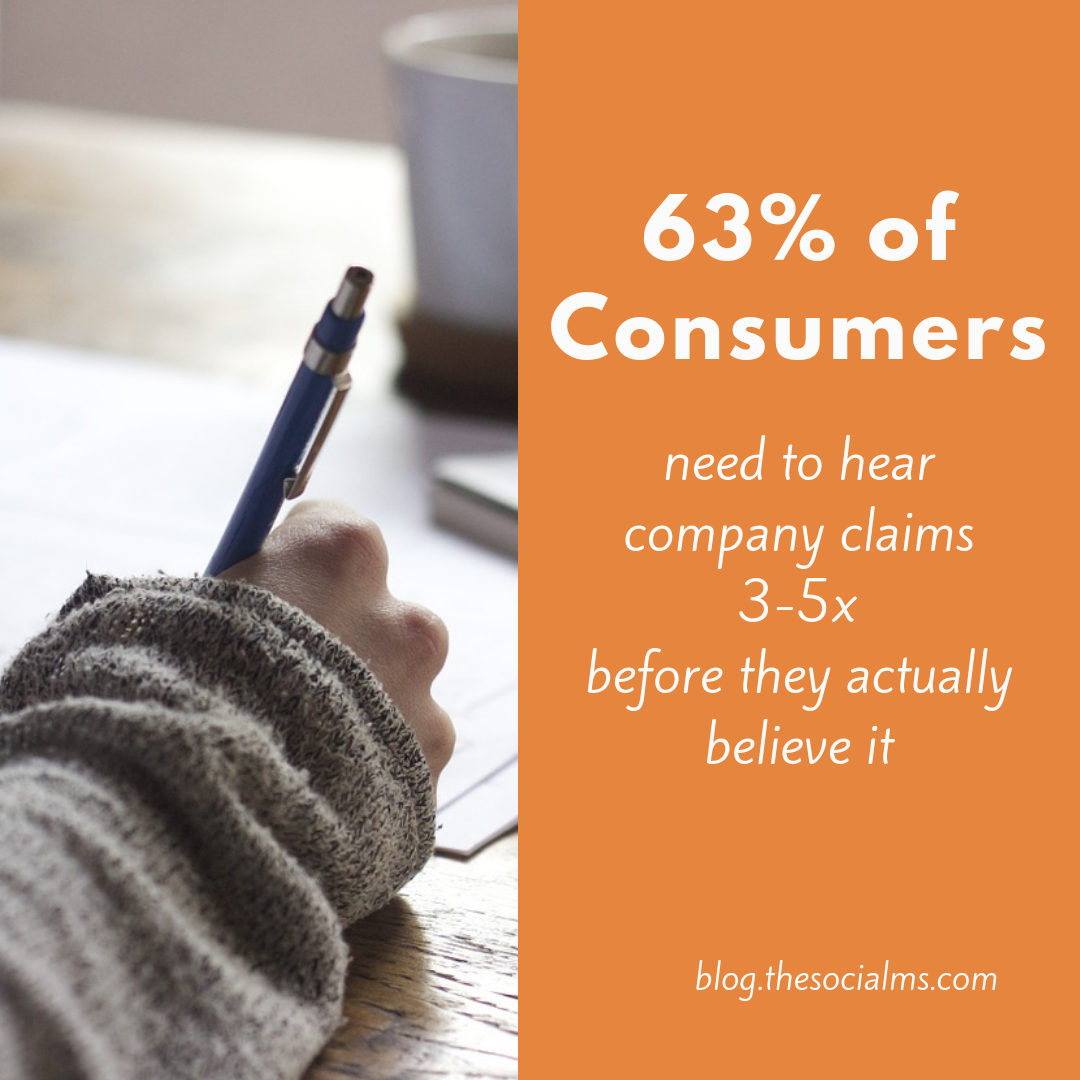
What you need:
- Email software
- Optional: More free content
- Informative emails.
Now that you know how to get traffic and how to turn web visitors into leads let’s move to the more exciting parts: Nurturing your subscribers into prospects for your products.
The prospect phase has two essential goals:
- Building trust
- Generating desire (for your products/services)
You do this by sending regular emails with contents that relate to the topics your target audience cares about.
The goal of every email should be to improve these two goals I mentioned above.
Once you start collecting emails, this also means that you need to immediately start sending emails. Every active subscriber should receive an email at least every week. If you send fewer emails, your subscribers will begin to forget about you.
See this post to see what you can write in your regular newsletters:
15 Email Ideas You Should Send to Your Subscribers (Without Boring Them To Death)
It’s a recommended practice to work with automated sequences of emails during this phase – and you can also allow your subscribers to opt into those sequences – for instance by clicking on a link in an email.
One option you have to build more trust ist to send more free content to your subscribers, just like the lead magnet you offered in return for the signup in the lead generation phase.
When is a lead ready for the sales phase?
One question that always comes up when talking about the nurturing phase is when is it time to move a lead to the sales phase.
The answer is simple and very problematic: You don’t know.
Every lead is different – remember you are talking to real people. Some people will trust you more quickly than others, some people react to different triggers and different arguments.
There are different ways to deal with this problem:
- Solution 1: Let a lead decide for himself when he or she is ready for the sales phase. You can do this by placing trigger links in your emails. For instance, a lead can receive an offer right after he downloaded a specific free content piece you’ve been offering in your email. Or you can send the lead a complete sequence of emails after they clicked on a particular link. There are multiple options you can use here, and email automation will make things a lot easier. Trigger Links are supported by all major email marketing software.
- Solution 2: Lead scoring. This is not really recommended for most sales funnels as it is more complicated and doesn’t really treat every lead differently. The idea is to score leads by actions they take. Opened an email? 1 point. Clicked on a link? 2 points. And so on. Once a lead passes a threshold, that lead will receive an automated sequence. Lead scoring is not supported by many email marketing solutions.
Both options allow you to move your lead back to your original list after the end of the automation if they didn’t buy afterward.
Sales Funnel Part 4: Sales
As you can see in the sales funnel diagram: Every sales funnel needs to end with a sales phase.
- Email Marketing Automation Software
- More pieces of free content
- Bonuses
- A solution to present time-limited offers
- Landing Pages (Clickfunnels, Leadpages)
Now that we have the nurturing phase described, let’s talk about how we finally move on to selling!
There are different ways to sell when a lead is ready to buy.
Let me give you various options of what you can do to increase your sales within your email list:
Tool 1: Have a Regular Offer
Let’s say you have an online course that you are valuing at $500 as a regular price.
There is nothing wrong with putting that offer below every regular email. This will remind your subscribers that the offer is there and they could buy it and benefit from it.
The primary function of this is not to make a lot of sales, but to show that you are actually selling something very powerful and could help them.
Tool 2: Tripwires
Tripwires are entry level offers. For instance – if you have a $500 course, you could start by presenting an ebook for $50. And once someone has bought this offer, you could offer the same person an upgrade to your full course system for a special price of $300.
The reason for this is that someone is far more likely to buy a cheap product first and then upgrade than to buy an expensive product.
Tool 3: Special Offers + Bonuses
Time limited special offers create an excellent reason for people to not just sit around and think about buying your course someday but to take action now.
You can increase the amount of pressure by also adding bonuses to offer – if you’re selling an ebook, for instance, you can add a second book as a bonus, or if you’re selling a complete online course system, you can add a whole set of bonuses – templates, cheat sheets, add a bonus course, …
Tool 4: Upsells
An often neglected tool that can add a LOT of additional revenues to your income stream if you add it to your sales funnel are Upsells.
Upsells are when you offer upgrades to your clients AFTER they have already made a purchase. For instance, if somebody bought your online course, you can provide a personal consulting session as an upgrade.
When you want to be really creative about this, you can offer various upsells after a purchase. A tactic that is often used is to provide an upsell right after the original investment that has about the same price as the original. And then you add another upsell with a price 3 times higher than the original product a week later.
Final Words
These were the building blocks for a perfect sales funnel along with a lot of information on how to use these sales funnel elements.
But that doesn’t mean that you’re done. Building a sales funnel for your blogging business is more complicated than just stringing events together to create them.
What you really need to focus on is the conversion from one phase to the next. And more importantly: Optimizing conversions of your leads from one stage to the next.
If you want to know how to build the perfect sales funnel for your blogging business, you can and should subscribe to our video course:

